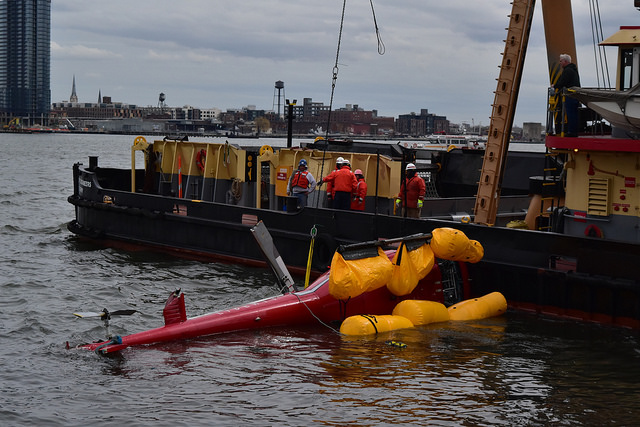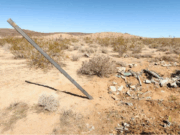
The Liberty Helicopters Eurocopter AS350 B2 that crashed in New York’s East River was equipped with a passenger harness system comprised of “off-the-shelf components” that required occupants to use an attached cutting tool to cut through the harnesses in case of an emergency, the U.S. National Transportation Safety Board (NTSB) says.
All five passengers were killed in the March 11 accident. The pilot escaped with minor injuries.
In a preliminary report released Monday, the NTSB said that the passenger harness system had not been installed by the helicopter manufacturer but rather that its components consisted of “a nylon fall-protection harness that was attached at the occupants’ back by a locking carabiner to a lanyard. The lanyard was composed of multiple woven fabric loops, and the opposite end of the lanyard was secured by another locking carabiner to a hard point on the helicopter. A small pouch was attached to the harness and contained a cutting tool.”
The pilot told accident investigators that he explained to passengers twice before the start of the aerial photography flight how to use a cutting tool attached to their safety harnesses to cut the harnesses in case of an emergency, the NTSB said. But the passengers were unable to follow the escape instructions after the AS350 rolled inverted and filled with water, the NTSB said.
The passengers were on what was to have been a 30-minute, doors-off photo flight operated by Liberty Helicopters for FlyNYON. The helicopter took off about 1900 local time from Kearny, New Jersey, and soon afterward, the pilot said he heard a low rotor rpm alert and observed engine pressure and fuel pressure warning lights; he believed that the engine had failed, the NTSB said.
The pilot told accident investigators that he established the helicopter in an autorotative glide and tried several times to restart the engine but failed. He activated the helicopter emergency float system, and, when he reached for the emergency fuel shutoff lever, found that it was in the “off” position with “a portion of the front seat passenger’s tether … underneath the lever,” the preliminary report said.
After the helicopter struck the water, the pilot said, he “turned the knurled screw” on the front seat passenger’s carabiner attachment to the helicopter. As the helicopter began listing at more than a 45-degree angle, he decided to exit the helicopter, he said.
“By the time he unbuckled his restraint, he was fully under water,” the report said. “He used two hands to grab the door frame and pull himself out. He surfaced about 4 ft [1 m] away from the nose of the helicopter and crawled up onto the belly. He stood up and waved for help but could not see anything.”
The report said examination of the emergency float system showed the floats on the left landing gear skid appeared to be more inflated than the floats on the right handing gear skid.
The NTSB’s investigation of the accident is continuing.
Caption: The U.S. Army Corps of Engineers vessel Driftmaster recovers the Liberty Helicopters’ AS350B2 that crashed in the East River March 11, 2018. NTSB photo by Chris O’Neil


